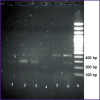NGS Technology in Monitoring the Genetic Diversity of Cytomegalovirus Strains
- PMID: 37389021
- PMCID: PMC10306971
- DOI: 10.17691/stm2023.15.2.04
NGS Technology in Monitoring the Genetic Diversity of Cytomegalovirus Strains
Abstract
Modern molecular genetic methods, massive parallel sequencing in particular, allow for genotyping of various pathogens with the aim of their epidemiological marking and improvement of molecular epidemiological surveillance of actual infections, including cytomegalovirus infection. The aim of the study is to evaluate the next-generation sequencing (NGS) technology for genotyping clinical isolates of cytomegalovirus (CMV).
Materials and methods: The object of the study were samples of biological substrates (leukocyte mass, saliva, urine) taken from patients who underwent liver and kidney transplantation. Detection of CMV DNA was carried out by a real-time PCR using commercial diagnostic AmpliSense CMV-FL test systems (Central Research Institute for Epidemiology, Moscow, Russia). DNA extraction was performed using DNA-sorb AM and DNA-sorb V kits (Central Research Institute for Epidemiology) in accordance with manufacturer's manual. The quality of the prepared DNA library for sequencing was assessed by means of the QIAxcel Advanced System capillary gel electrophoresis system (QIAGEN, Germany). Alignment and assembly of nucleotide sequences were carried out using CLC Genomics Workbench 5.5 software (CLC bio, USA). The sequencing results were analyzed using BLAST of NCBI server.
Results: CMV DNA samples were selected for genotyping. The two variable genes, UL55(gB) and UL73(gN), were used for CMV genotype determination, which was performed using NGS technology MiSeq sequencer (Illumina, USA). Based on the exploratory studies and analysis of literature sources, primers for genotyping on the UL55(gB) and UL73(gN) genes have been selected and the optimal conditions for the PCR reaction have been defined. The results of sequencing the UL55(gB) and UL73(gN) gene fragments of CMV clinical isolates from recipients of solid organs made it possible to determine the virus genotypes, among which gB2, gN4c, and gN4b were dominant. In some cases, association of two and three CMV genotypes has been revealed.
Conclusion: The application of the NGS technology for genotyping cytomegalovirus strains can become one of the main methods of CMV infection molecular epidemiology, as it allows for obtaining reliable results with a significant reduction in research time.
Keywords: NGS technology; cypomegalovirus genotyping; cytomegalovirus.
Conflict of interest statement
Conflicts of interest. The authors have no conflicts of interest to declare.
Figures


References
-
- Zhebrun A.B., Kulyashova L.B., Ermolenko K.D., Zakrevskaya A.V. Spread of herpesvirus infections in children and adults in St. Petersburg according to seroepidemiologic study data. Zhurnal mikrobiologii, epidemiologii i immunobiologii. 2013;6:30–36. - PubMed
-
- Dmitrachenko T.I., Harbachou V.V., Semenov V.M., Ziankova S.K., Shpigun N.V. Reactivation of cytomegalovirus infection in patients being in critical state. Vestnik Vitebskogo gosudarstvennogo medicinskogo universiteta. 2018;17(3):25–37.
-
- Suárez N.M., Wilkie G.S., Hage E., Camiolo S., Holton M., Hughes J., Maabar M., Vattipally S.B., Dhingra A., Gompels U.A., Wilkinson G.W.G., Baldanti F., Furione M., Lilleri D., Arossa A., Ganzenmueller T., Gerna G., Hubáček P., Schulz T.F., Wolf D., Zavattoni M., Davison A.J. Human cytomegalovirus genomes sequenced directly from clinical material: variation, multiple-strain infection, recombination, and gene loss. J Infect Dis. 2019;220(5):781–791. doi: 10.1093/infdis/jiz208. - DOI - PMC - PubMed
MeSH terms
LinkOut - more resources
Full Text Sources
Medical
Research Materials
